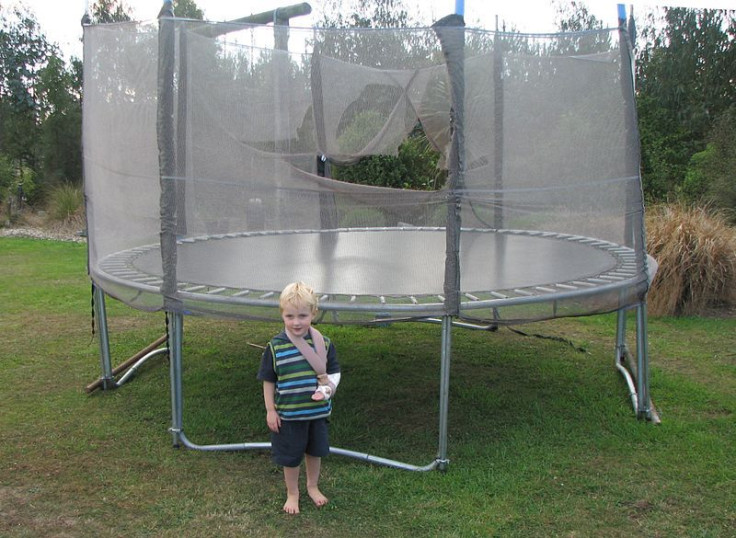Kids’ Injuries Soar High In Trampoline Parks; Doctor Says It's Like 'A War Type Of Injury Or A Motor Vehicle Crash'

Springing and tumbling up and down with a crowd of people as you fall into a pit full of foam sounds like an ideal recreational activity for kids and adults any day. Trampoline parks are usually equipped with enclosed nets and padding to reduce the risk of injury among participants, especially children. According to a report from the American Academy of Pediatrics, 70 injuries occurred for every 100,000 kids between the ages of zero and four using a trampoline, while 160 injuries out of 100,000 occurred between the ages of five to 14 years old. With approximately 98,000 trampoline park-related injuries occurring each year, operators of the jump gyms make jumpers sign a waiver before they bounce around. But the waivers, enclosed nets, and pads are not enough to ensure the safety of the jumpers, according to Dr. Craig Cook, trauma director at Utah Valley Regional Medical Center. "This is like a war type of injury or a motor vehicle crash,” he said. The severity of trampoline injuries calls for greater enforcement of local laws in trampoline parks across the nation.
Paralyzed Case: Stephen Merrill
For 22-year-old Stephen Merrill of Provo, Utah, a trip to an indoor trampoline park with his friends turned into a potentially fatal leap. The then 20-year-old college freshman leaped from the trampoline into a pit full of foam blocks, went directly through them, and landed on his head, reports the Associated Press. The result of his injury was broken vertebrae in his neck, leaving him paralyzed from the neck down. "It doesn't seem like things are properly regulated if something like that is possible,” said Merrill.
Lowes Extreme Air Sports, the site where Merrill’s devastating injury occurred, claims that he violated the facility’s rules and thus led himself to being paralyzed. Misty Uribe, who manages the indoor jump gym, says that there is one major injury for every 20,000 visitors that come to her facility – Merrill accounts for that one injury. Although Uribe says Merrill’s accident prompted her jump gym to make the pits of foam safer for jumpers, she believes that the trampoline industry is being picked on by health officials. "My concern is, once they start with this, where is it going to end?" she said about the regulations under review by the Utah County Health Board.
Read more: How To Avoid Traumatic Brain Injuries From Sports
Trampoline Safety Law: Utah, California And Colorado
At the Utah Valley Regional Medical Center, based on its emergency room records, there was a total of 52 injuries from trampoline parks that required numerous doctor visits from May 2011 to November 2012. The majority of these injuries occured in males who average 19 years old.
While Uribe and other jump gym operators may consider the injury statistics to be considerably small for the number of visitors that their gyms get, the effects of these injuries are much more severe and can be detrimental to children’s health. In Orem, Utah, Aaron Cobabe, owner of Get Air Hang Time, requires jumpers to sign a waiver, watch a safety video, and make note of the risks of "serious catastrophic injury or death" from the recreational activity, reports the Associated Press. Cobabe said that between July 2012 and July 2013, his gym has had 11 major injuries that required multiple doctor visits out of more than 150,000 visitors. While Cobabe addresses the risk of serious catastrophic injury to visitors of his jump gym, injuries still seem inevitable. But, local laws in Utah and California are set to regulate these dangerous trampoline parks.
California has taken the initiative to create an inspection program for the jump gyms — similar to that of amusement parks. The program will require facilities to show proof of insurance, employee training, and injury reporting, says CBS. Utah’s proposals will be similar to California’s legislation, if approved.
Trampoline Safety At Home
Trampolines are found not only in jump gyms, but also in the backyards of American households. If you or someone you know owns a trampoline, follow Mayo Clinic’s safety rules below:
- Use safety nets and pads. Install a trampoline enclosure — a special net designed to surround the trampoline — and cover the trampoline's springs, hooks, and frame with shock-absorbing pads. Regularly check the equipment for tears and detachments.
- Place the trampoline on level ground. Make sure it's a safe distance from trees and other structures. Better yet, place the trampoline in a pit so the jumping surface is at ground level.
- Limit trampoline activity. Allow only one person to use the trampoline at a time — and never without supervision. Don't allow somersaults or other potentially risky moves on the trampoline.
- Discourage unsupervised jumping. Don't install a trampoline ladder, which could tempt young children to use the trampoline alone.



























